Order-8 triangular tiling
In geometry, the order-8 triangular tiling is a regular tiling of the hyperbolic plane. It is represented by Schläfli symbol of {3,8}, having eight regular triangles around each vertex.
| Order-8 triangular tiling | |
|---|---|
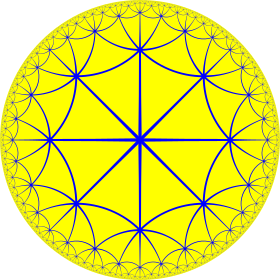 Poincaré disk model of the hyperbolic plane | |
| Type | Hyperbolic regular tiling |
| Vertex configuration | 38 |
| Schläfli symbol | {3,8} (3,4,3) |
| Wythoff symbol | 8 | 3 2 4 | 3 3 |
| Coxeter diagram | |
| Symmetry group | [8,3], (*832) [(4,3,3)], (*433) [(4,4,4)], (*444) |
| Dual | Octagonal tiling |
| Properties | Vertex-transitive, edge-transitive, face-transitive |
Uniform colorings
The half symmetry [1+,8,3] = [(4,3,3)] can be shown with alternating two colors of triangles:
Symmetry
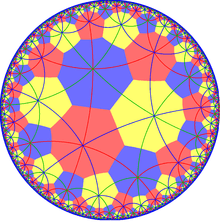
From [(4,4,4)] symmetry, there are 15 small index subgroups (7 unique) by mirror removal and alternation operators. Mirrors can be removed if its branch orders are all even, and cuts neighboring branch orders in half. Removing two mirrors leaves a half-order gyration point where the removed mirrors met. In these images fundamental domains are alternately colored black and white, and mirrors exist on the boundaries between colors. Adding 3 bisecting mirrors across each fundamental domains creates 832 symmetry. The subgroup index-8 group, [(1+,4,1+,4,1+,4)] (222222) is the commutator subgroup of [(4,4,4)].
A larger subgroup is constructed [(4,4,4*)], index 8, as (2*2222) with gyration points removed, becomes (*22222222).
The symmetry can be doubled to 842 symmetry by adding a bisecting mirror across the fundamental domains. The symmetry can be extended by 6, as 832 symmetry, by 3 bisecting mirrors per domain.
| Index | 1 | 2 | 4 | |||
|---|---|---|---|---|---|---|
| Diagram | 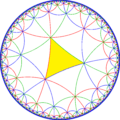 |
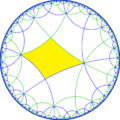 |
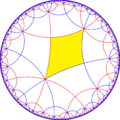 |
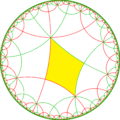 |
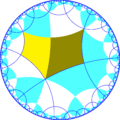 |
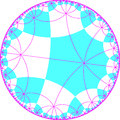 |
| Coxeter | [(4,4,4)] |
[(1+,4,4,4)] |
[(4,1+,4,4)] |
[(4,4,1+,4)] |
[(1+,4,1+,4,4)] |
[(4+,4+,4)] |
| Orbifold | *444 | *4242 | 2*222 | 222× | ||
| Diagram | 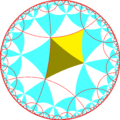 |
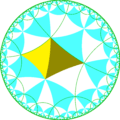 |
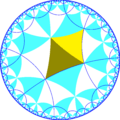 |
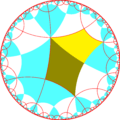 |
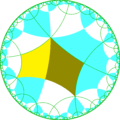 | |
| Coxeter | [(4,4+,4)] |
[(4,4,4+)] |
[(4+,4,4)] |
[(4,1+,4,1+,4)] |
[(1+,4,4,1+,4)] | |
| Orbifold | 4*22 | 2*222 | ||||
| Direct subgroups | ||||||
| Index | 2 | 4 | 8 | |||
| Diagram |  |
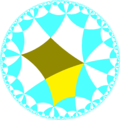 |
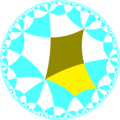 |
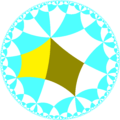 |
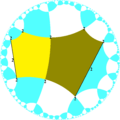 | |
| Coxeter | [(4,4,4)]+ |
[(4,4+,4)]+ |
[(4,4,4+)]+ |
[(4+,4,4)]+ |
[(4,1+,4,1+,4)]+ | |
| Orbifold | 444 | 4242 | 222222 | |||
| Radical subgroups | ||||||
| Index | 8 | 16 | ||||
| Diagram | 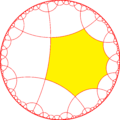 |
 |
 |
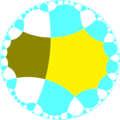 |
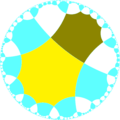 |
 |
| Coxeter | [(4,4*,4)] | [(4,4,4*)] | [(4*,4,4)] | [(4,4*,4)]+ | [(4,4,4*)]+ | [(4*,4,4)]+ |
| Orbifold | *22222222 | 22222222 | ||||
Related polyhedra and tilings

| *n32 symmetry mutation of regular tilings: {3,n} | |||||||||||
|---|---|---|---|---|---|---|---|---|---|---|---|
| Spherical | Euclid. | Compact hyper. | Paraco. | Noncompact hyperbolic | |||||||
 |
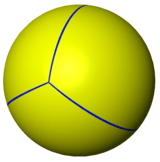 |
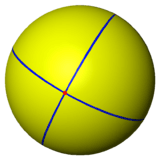 |
 |
 |
 |
 |
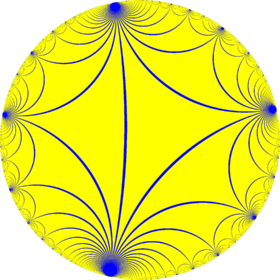 |
 |
 |
 |
 |
| 3.3 | 33 | 34 | 35 | 36 | 37 | 38 | 3∞ | 312i | 39i | 36i | 33i |
From a Wythoff construction there are ten hyperbolic uniform tilings that can be based from the regular octagonal and order-8 triangular tilings.
Drawing the tiles colored as red on the original faces, yellow at the original vertices, and blue along the original edges, there are 10 forms.
| Uniform octagonal/triangular tilings | |||||||||||||
|---|---|---|---|---|---|---|---|---|---|---|---|---|---|
| Symmetry: [8,3], (*832) | [8,3]+ (832) |
[1+,8,3] (*443) |
[8,3+] (3*4) | ||||||||||
| {8,3} | t{8,3} | r{8,3} | t{3,8} | {3,8} | rr{8,3} s2{3,8} |
tr{8,3} | sr{8,3} | h{8,3} | h2{8,3} | s{3,8} | |||
| Uniform duals | |||||||||||||
| V83 | V3.16.16 | V3.8.3.8 | V6.6.8 | V38 | V3.4.8.4 | V4.6.16 | V34.8 | V(3.4)3 | V8.6.6 | V35.4 | |||
| Regular tilings: {n,8} | |||||||||||
|---|---|---|---|---|---|---|---|---|---|---|---|
| Spherical | Hyperbolic tilings | ||||||||||
 {2,8} |
 {3,8} |
 {4,8} |
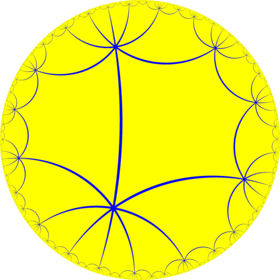 {5,8} |
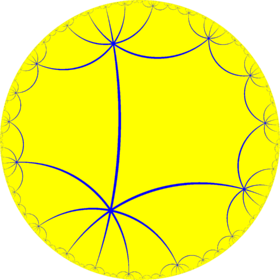 {6,8} |
 {7,8} |
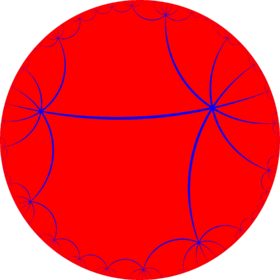 {8,8} |
... |  {∞,8} | |||
It can also be generated from the (4 3 3) hyperbolic tilings:
| Uniform (4,3,3) tilings | |||||||||||
|---|---|---|---|---|---|---|---|---|---|---|---|
| Symmetry: [(4,3,3)], (*433) | [(4,3,3)]+, (433) | ||||||||||
 |
 |
 |
 |
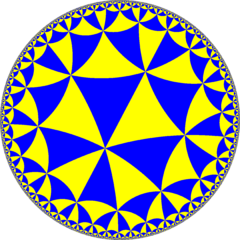 |
 |
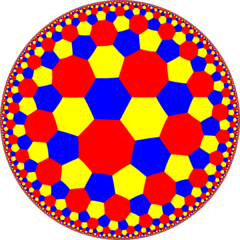 |
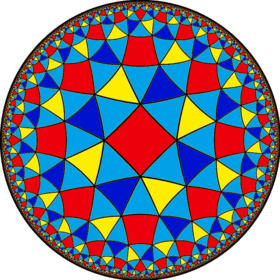 | ||||
| h{8,3} t0(4,3,3) |
r{3,8}1/2 t0,1(4,3,3) |
h{8,3} t1(4,3,3) |
h2{8,3} t1,2(4,3,3) |
{3,8}1/2 t2(4,3,3) |
h2{8,3} t0,2(4,3,3) |
t{3,8}1/2 t0,1,2(4,3,3) |
s{3,8}1/2 s(4,3,3) | ||||
| Uniform duals | |||||||||||
 |
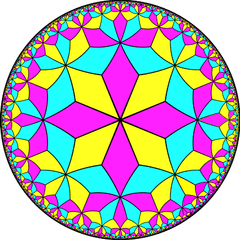 |
 |
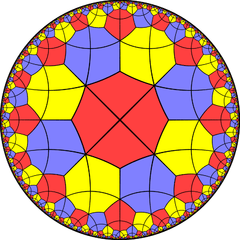 |
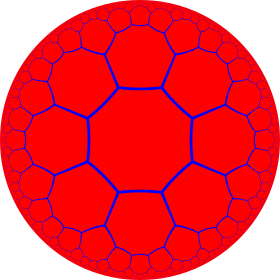 |
 |
 |
 | ||||
| V(3.4)3 | V3.8.3.8 | V(3.4)3 | V3.6.4.6 | V(3.3)4 | V3.6.4.6 | V6.6.8 | V3.3.3.3.3.4 | ||||
| Uniform (4,4,4) tilings | |||||||||||
|---|---|---|---|---|---|---|---|---|---|---|---|
| Symmetry: [(4,4,4)], (*444) | [(4,4,4)]+ (444) |
[(1+,4,4,4)] (*4242) |
[(4+,4,4)] (4*22) | ||||||||
 |
 |
 |
 |
 |
 |
 |
 |
 |
 | ||
| t0(4,4,4) h{8,4} |
t0,1(4,4,4) h2{8,4} |
t1(4,4,4) {4,8}1/2 |
t1,2(4,4,4) h2{8,4} |
t2(4,4,4) h{8,4} |
t0,2(4,4,4) r{4,8}1/2 |
t0,1,2(4,4,4) t{4,8}1/2 |
s(4,4,4) s{4,8}1/2 |
h(4,4,4) h{4,8}1/2 |
hr(4,4,4) hr{4,8}1/2 | ||
| Uniform duals | |||||||||||
 |
 |
 |
 |
 |
 |
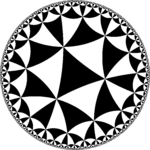 |
 |
 |
 | ||
| V(4.4)4 | V4.8.4.8 | V(4.4)4 | V4.8.4.8 | V(4.4)4 | V4.8.4.8 | V8.8.8 | V3.4.3.4.3.4 | V88 | V(4,4)3 | ||
See also
| Wikimedia Commons has media related to Order-8 triangular tiling. |
- Order-8 tetrahedral honeycomb
- Tilings of regular polygons
- List of uniform planar tilings
- List of regular polytopes
References
- John H. Conway, Heidi Burgiel, Chaim Goodman-Strass, The Symmetries of Things 2008, ISBN 978-1-56881-220-5 (Chapter 19, The Hyperbolic Archimedean Tessellations)
- "Chapter 10: Regular honeycombs in hyperbolic space". The Beauty of Geometry: Twelve Essays. Dover Publications. 1999. ISBN 0-486-40919-8. LCCN 99035678.
